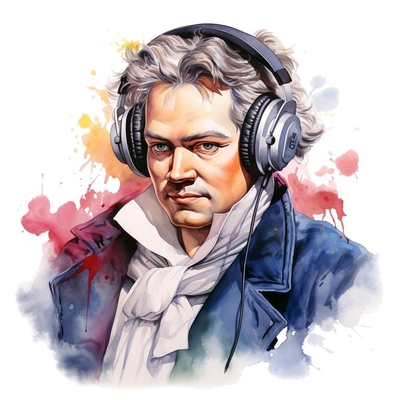BEETHOVEN'S VIOLIN CONCERTO IN D MAJOR
- 'I. ALLEGRO MA NON TROPPO' -

Hello, I'm Beethoven, and I'm thrilled to share the intricacies of the I. Allegro ma non troppo movement from my Violin Concerto in D Major. Are you curious about the stirring melodies and the underlying complexities of this beloved movement? I'm here to enlighten you with a detailed tour through the enchanting musical passages of the Allegro ma non troppo. After we delve into its rich textures and harmonies, I'll suggest paths for you to further explore the vast landscape of my Violin Concerto in D Major.
---
Tuning In: The Orchestra's Cast of Characters
Alright, imagine you're at a party and everyone's got a role to play. In 'I. Allegro ma non troppo', the violin is like the charming storyteller, weaving tales while the orchestra sets the scene. The woodwinds, brass, and strings are like the supportive friends, chiming in with their own quips, while the timpani is that one friend who punctuates the punchlines with a well-timed drum thump.What's in a Name: The Mystery of 'Allegro ma non troppo'
So, why did I call this piece 'Allegro ma non troppo', you ask? Well, 'Allegro' means 'fast', but I'm not one to just rush through a story without giving you time to savor it, hence 'ma non troppo' - 'but not too much'. It's like telling the violin, 'Hey, show off your moves, but let's not turn this into a sprint, okay?'The Blueprint: Crafting the Musical Journey
Choosing the form for 'I. Allegro ma non troppo' was an adventure in itself. It's structured as a sonata form, which is like the classic 'beginning, middle, and end' of a good story, but with a musical twist. I'll just touch on the sections here, but get ready, because I'm going to dive into each section one by one in the next few paragraphs.Section 1: The Grand Entrance
We kick things off with a grand orchestral introduction, setting the stage for our soloist's grand entrance. It's like the opening scene of a play, where the setting is established before the main character steps in. The mood is expectant, the tempo is lively, but I keep you waiting just a bit before the violin takes the spotlight.Section 2: The Plot Thickens
Now, the violin takes the lead, and the narrative really starts to unfold. The soloist spins a melody that's both spirited and lyrical, like a hero embarking on a quest. The orchestra supports, converses, and sometimes even challenges our protagonist, adding layers to the story.Section 3: The Heartfelt Dialogue
In the development section, things get intense - it's like the heart-to-heart moment in a drama. The violin and orchestra delve into deeper, more complex conversations, with key changes that feel like plot twists. The mood shifts, the tempo fluctuates, and the music takes you on a rollercoaster of emotions.Section 4: The Triumphant Recap
Just when you think you've heard it all, we circle back to the recapitulation. It's a triumphant return to the themes you've grown to love, but with a sense of victory after the trials of the development. The violin reasserts its narrative, the orchestra rallies behind it, and together they sprint towards the grand finale.Encore: The Final Bow
Now, I invite you to experience 'I. Allegro ma non troppo' for yourself. Hit the play button and let yourself be immersed in the music. As you listen, maybe keep in mind what we've talked about, and I hope you find the journey through my 'I. Allegro ma non troppo' as thrilling as I did when creating it!---
Did you have a delightful time delving into the intricacies of my Violin Concerto in D Major's I. Allegro ma non troppo? Trust me, the rabbit hole goes even deeper: there's a whole symphony of elements in the concerto still waiting for you to discover. Feel free to click on the links below to embark on your next adventure and uncover the remaining secrets of this timeless piece.
